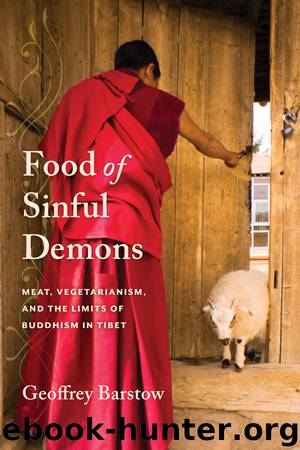Food of Sinful Demons by Geoffrey Barstow

Author:Geoffrey Barstow
Language: eng
Format: epub
Publisher: Columbia University Press
FIGURE 6.4 Neolithic rock art depicting an archer (left) aiming at a four-legged animal, probably a deer (right). Image © John Vincent Bellezza. Used with permission.
Dotson focuses his analysis on the Imperial Period, but hunting has remained an important part of Tibetan culture down to the present day. Numerous anthropological accounts mention the importance of hunting to many communities. Rinzin Thargyal, for instance, notes that in Kham during the 1940s, hunting provided both meat for personal consumption and valuable animal products (such as horn and musk) that could be sold.56 On the contemporary Changtang Plateau, John Bellezza notes that nomads continue to maintain hunting traditions, including a specific pantheon of zoomorphic deities that assist in the hunt.57 Further, biographies of religious leaders frequently attest to their efforts to end hunting in their regions. Jigmé Lingpa’s Autobiography, to give one example among many, records no less that three separate occasions when Jigmé Lingpa purchased an entire mountain for the sole purpose of ending hunting by “sealing” the site.58 The frequency with which various lamas attempted to end hunting points to the fact that hunting, despite the lamas’ entreaties, remained widespread.
Given the many lamas who have critiqued hunting over the years, we might expect its practitioners to engage in it reluctantly, perhaps viewing it as a necessary evil, just as many Tibetans viewed meat eating. The available sources, however, suggest that far from being embarrassed by or regretting their actions, many hunters actually took pride in their skills. This is certainly the case in contemporary Tibet, where young men routinely brag about their ability to kill difficult game. In their discussion of nomadic life in mid-1980s western Tibet, Goldstein and Beall quote a young man who recalls being proud of his ability as a hunter, only coming to regret his actions after a series of misfortunes he blamed on the negative karma he had accrued through hunting.59 While this man ultimately adopts a Buddhistic attitude toward hunting, his earlier actions are far more reminiscent of the heroic ideal.
A similar pattern can be seen in pre-communist textual material as well. It is a fairly common trope in Buddhist texts for a lama to encounter a hunter in the mountains, point out the immorality of hunting and, ultimately, convert the hunter to Buddhistic morality. Perhaps the most famous of these comes from a fifteenth-century account of the famed twelfth-century hermit Milarepa, who encounters an angry hunter only to subdue and tame him by singing religious songs.60 A more telling version of this type of encounter, however, can be found in Jigmé Lingpa’s Song of the Hunted Deer, a text already encountered in chapter 2. In this text, a man hunting deer deep in the mountains comes across a hermit meditating in a cave. The hermit rebukes the hunter for his immoral conduct, but the hunter pushes back, accusing the hermit of hypocrisy, pointing out that if people like the hermit didn’t buy meat, people like the hunter wouldn’t hunt. In the end, the hermit wins the argument and the hunter repents.
Download
This site does not store any files on its server. We only index and link to content provided by other sites. Please contact the content providers to delete copyright contents if any and email us, we'll remove relevant links or contents immediately.
The Vikings: Conquering England, France, and Ireland by Wernick Robert(79845)
Ali Pasha, Lion of Ioannina by Eugenia Russell & Eugenia Russell(40103)
The Conquerors (The Winning of America Series Book 3) by Eckert Allan W(36960)
The Vikings: Discoverers of a New World by Wernick Robert(36903)
Cecilia; Or, Memoirs of an Heiress — Volume 1 by Fanny Burney(32396)
Cecilia; Or, Memoirs of an Heiress — Volume 3 by Fanny Burney(31775)
Cecilia; Or, Memoirs of an Heiress — Volume 2 by Fanny Burney(31744)
Empire of the Sikhs by Patwant Singh(22922)
The Secret History by Donna Tartt(18787)
Hans Sturm: A Soldier's Odyssey on the Eastern Front by Gordon Williamson(18448)
Cat's cradle by Kurt Vonnegut(15126)
Pimp by Iceberg Slim(14255)
Sapiens: A Brief History of Humankind by Yuval Noah Harari(14183)
Talking to Strangers by Malcolm Gladwell(13156)
Norse Mythology by Gaiman Neil(13154)
Leonardo da Vinci by Walter Isaacson(13128)
4 3 2 1: A Novel by Paul Auster(12245)
Underground: A Human History of the Worlds Beneath Our Feet by Will Hunt(11992)
The Radium Girls by Kate Moore(11886)
